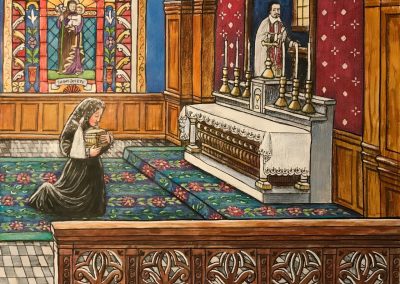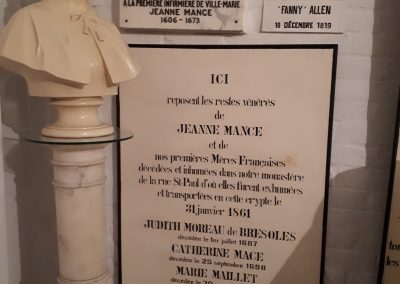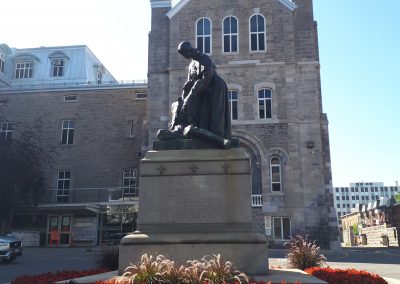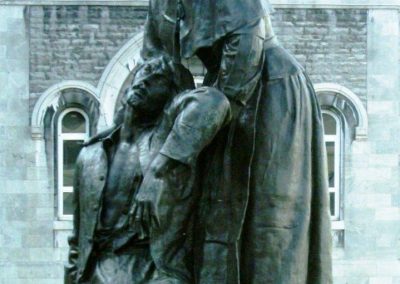Venerable Jeanne Mance
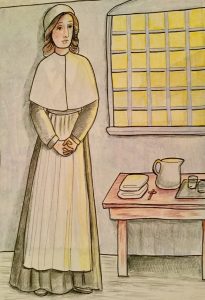 Jeanne Mance was born on November 12, 1606 in the city of Langres, France. On the same day, she was baptized in the Saint-Pierre-Saint-Paul church. She was the second of twelve children born to Charles Mance, the King’s attorney of France in Langres, and Catherine Emonnot, daughter of the attorney Laurent Emonnot. At the age of 16, seriously ill, she was barely saved by the doctors. Her health was predicted to be fragile for the rest of her life.
Jeanne Mance was born on November 12, 1606 in the city of Langres, France. On the same day, she was baptized in the Saint-Pierre-Saint-Paul church. She was the second of twelve children born to Charles Mance, the King’s attorney of France in Langres, and Catherine Emonnot, daughter of the attorney Laurent Emonnot. At the age of 16, seriously ill, she was barely saved by the doctors. Her health was predicted to be fragile for the rest of her life.
Jeanne was very active in this bourgeois family and in her father’s law office. Her father died in the early summer of 1630, followed by her mother two years later in July 1632. With her sister Marguerite, Jeanne had to work to ensure the subsistence of her minor brothers and sisters.
Not being inclined to religious life or marriage, Jeanne took up the profession of nursing, devoting herself to the victims of the Thirty Years’ War and the plague, two scourges that ravaged Langres in the 1630s.
In 1640, Jeanne hurried to visit a priest cousin she loved, Father Nicolas Dolebeau. The young man talked to her about New France. He told of the prodigious vocation of Mrs. de La Peltrie and the Ursulines she was taking to New France. He told her how Mrs. de La Peltrie had been miraculously healed after promising St. Joseph to consecrate her life for Canada. He also told her how St. Mary of the Incarnation had a dream in which she saw herself going to a wilderness with Mrs. de La Peltrie and that St. Joseph appeared in the dream to show her the way; and that she later heard the voice of God say to her: “It is Canada that I have shown you. I want you to go there and found a house for Jesus and Mary. After hearing these things, Jeanne Mance had the desire to go and help the missions in Canada.
In that same year of 1640, with the authorization of her Jesuit spiritual advisor, she left Langres and her brothers and sisters for Paris to seek the means to go to this land of promise. She met Father Charles Lalement, a Jesuit, procurator of the missions of Canada, who told her about God’s plans for New France. Father Jean-Baptiste Saint-Jure, a Jesuit, discerned in her a true missionary vocation and strongly encouraged her.
Jeanne spent a year in Paris. She met influential people who would contribute to the direction of her destiny. For example, Claude de Bullion found in her a strong, wise woman and a nurse with a compassionate heart. She proposed to her to create a hospital and promised her the necessary funds for its establishment. After consultation and prayerful reflection, Jeanne accepted, but the location of the hospital remained unknown.
She learned from the Jesuit Fathers in Paris about the missionary project of a layman, Jérôme Le Royer de La Dauversière. Visionary and initiator of this project, he had set up with Father Jean-Jacques Olier, founder of the Priests of Saint-Sulpice, the Society of Our Lady of Montreal, responsible for the realization of the most beautiful apostolic dream: the establishment, on the island of Montreal, of a city dedicated to Mary for the evangelization of the native peoples.
Jeanne’s mission became more precise. She went to La Rochelle where Jérôme Le Royer prepared to embark for Montreal. They exchanged a glance charged with an extraordinary clairvoyance, for, according to the true motives, “having greeted each other without ever having seen or heard of each other, in an instant God imprinted in their minds a knowledge of their interior and of their purpose so clear, that having recognized each other, they could not do otherwise than thank God for his favors. Jérôme Le Royer said to him: “Heaven had informed me of your visit! Then, Jérôme told her how he had had a vision of the Holy Family, asking her to found a city on the island of Montreal, in order to evangelize the Indians. He discovered in Jeanne Mance “a gift from heaven”, a person “all grace” chosen by God and who arrived at the right time. He invites her to join the Society of Notre-Dame and the expedition, just like Paul de Chomedey. She opted for the risk and became involved in the heroic adventure of the Founders of Montreal.
Paul de Maisonneuve and Jeanne Mance set sail to found Montreal. When they arrived in Quebec City, people called them crazy for wanting to found a city on an island not far from the Iroquois. Paul de Maisonneuve said: “It is my honor to accomplish my mission, should all the trees on the island of Montreal turn into so many Iroquois.
Montreal was founded in 1642. However, the St. Lawrence River was overflowing, threatening to destroy the work so painstakingly accomplished. Then Maisonneuve stood up and made a vow. He promised to put a cross on Mount Royal if the flooding stopped. The river became calm again.
On March 30, 1644, the watchdogs, trained to detect the approach of the Iroquois, began to howl in the direction of the woods. The French, tired of hiding, asked Maisonneuve to take the initiative for an attack. He took the lead of a small group of 30 men and made a sortie. They found themselves surrounded by about 200 Iroquois and an unequal battle ensued. The French fought bravely, but when the powder ran out, they fled back to the fort, leaving Maisonneuve behind. He was attacked by one of the Iroquois chiefs and a violent hand-to-hand fight ensued between the two men. The Iroquois tried to slit Maisonneuve’s throat, but the latter opened fire on the Indian at point-blank range and the attacker fell dead. The Iroquois warriors stopped the attack, took their leader on their shoulders and retreated. Maisonneuve returned to the fort a hero. As the number of French soldiers was running out, the venerable Jeanne Mance gave all her reserve money so that Maisonneuve could go to France to recruit soldiers.
In 1652, during his trip to France, Paul de Maisonneuve visited his sister (who was friends with Saint Marguerite Bourgeoys). He invited Saint Marguerite Bourgeoys to come and found a school. Marguerite Bourgeoys was hesitant, but finally accepted the task after the Virgin Mary appeared to her and said, “Go, I will not abandon you.
A few years later, on January 28, 1657, while returning from mass, Jeanne Mance fell on the ice, broke her right arm and dislocated her wrist. This fall had serious consequences. The doctors managed to heal the fracture, but did not notice the condition of the wrist; although healed, Jeanne Mance was unable to use her arm. Because of this infirmity, she had to think about having herself replaced at the head of the hospital. However, she waited for the return of M. de Maisonneuve, who left for France in 1655. He was not to return until the end of July 1657, accompanied by the first parish clergy of Ville-Marie, which would consist of three Sulpicians under the authority of the Abbé de Queylus. But as fate would have it, Mr. Olier, who had chosen these four missionaries himself, died only a few days before the priests embarked. Jeanne, who had hastened to consult Mr. de Maisonneuve upon her arrival, had to postpone her trip to France until the following year. Her health left much to be desired. She left in the fall of 1658, accompanied by Marguerite Bourgeoys, who had become her faithful friend. When she arrived in France, Jeanne went to pray at the tomb of Father Jean-Jacques Olier, founder of the Sulpicians, who had helped them greatly in their efforts to found Montreal. Taking the box containing the heart of the holy priest, Jeanne was suddenly healed. She was able to return to Montreal, with St. Marguerite Bourgeoys, to continue their great mission.
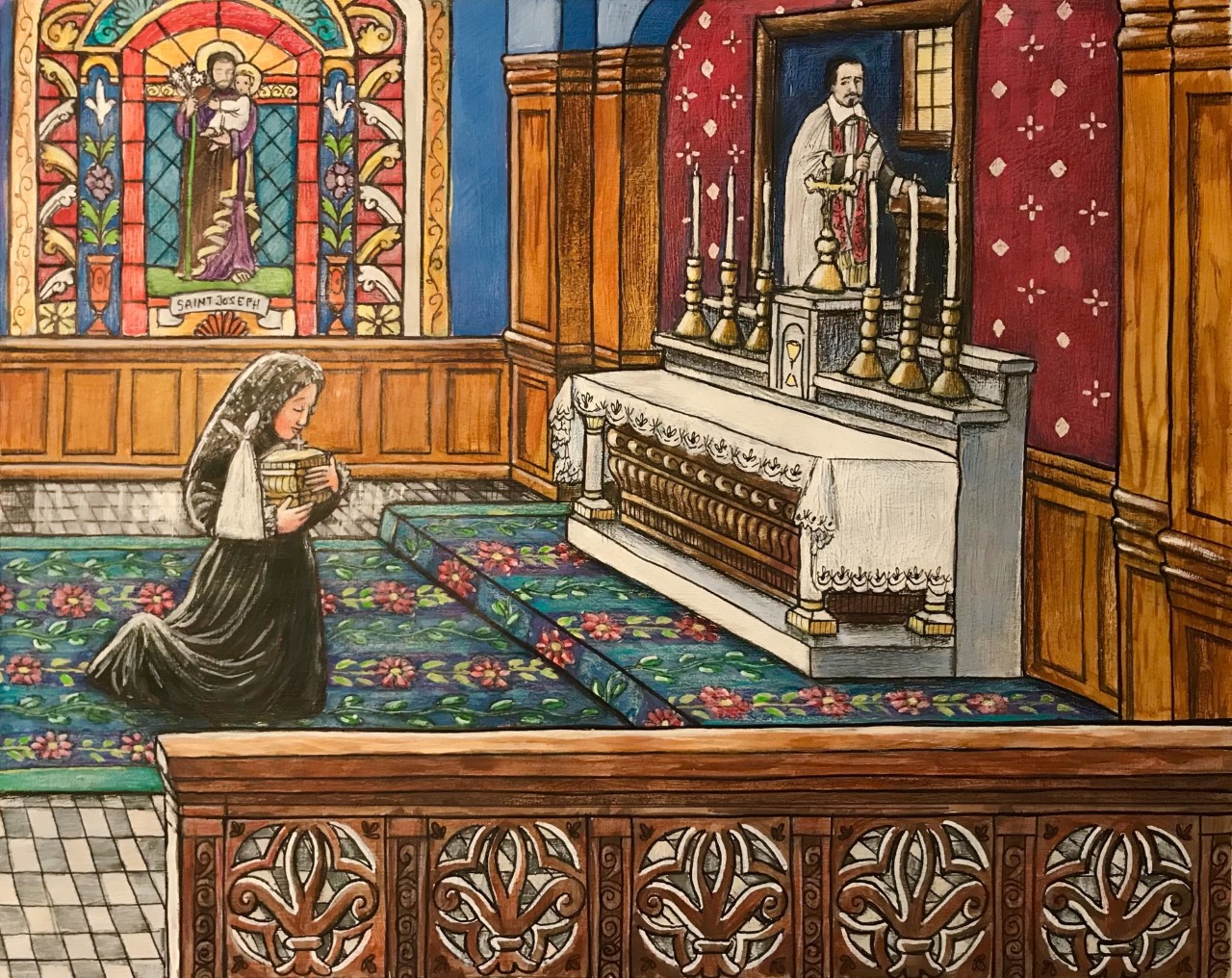
Despite her illness, she writes a will herself from May 1669 and finishes on February 16, 1672. She died on June 18, 1673. In her will, she bequeathed her heart to the people of Montreal and asked the Hospitallers to take care of her body. Her remains were placed in the crypt of the chapel of the present Hôtel-Dieu of Montreal, where she still rests today at the following address: 201 Pine Avenue West, Montreal, QC.
Sources:
DAVELUY, Marie-Claire, Jeanne Mance, Fides edition

